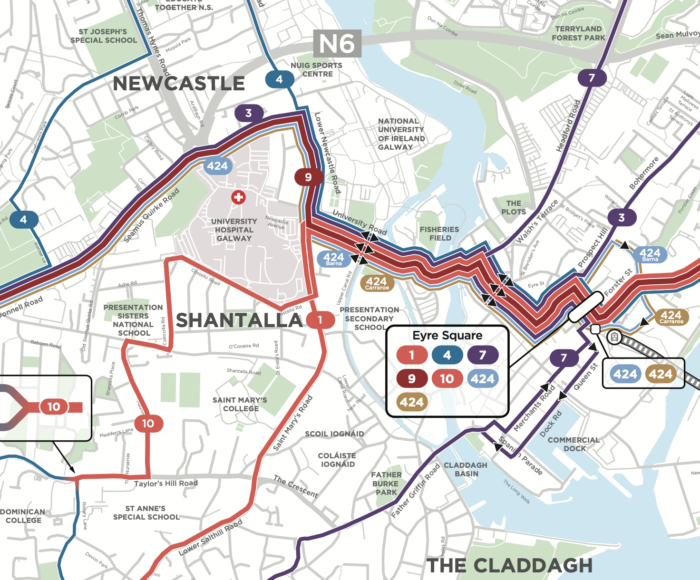We’ve been honored to work with the National Transport Authority of Ireland on proposed network redesigns for all of the Irish Republic’s major cities: Dublin back in the late 2010s, Cork over the last two years, and now Galway and Limerick. (Waterford is coming next year.) The Galway plan is out now. You can explore it here. You can view the new network map here and compare it to our drawing of the current one, in the same style which is here.
Some key facts:
- 38% more jobs reachable within 30 minutes on weekdays (daytime) for the average resident
- And +43% on Saturdays, +54% on Sundays
- one-third of residents would be within a 5 minute walk of a frequent route, which is nearly double the current number
- nearly one-half of jobs would be within a 5 minute walk of a frequent route, up from 30% on the existing network
- and of course many people are willing to walk more than 5 minutes to reach high frequency service
- More residents and jobs covered by service of any frequency
- More evening and weekend service
- A new 24-hour route (Route 9) across the city
- About 50% more service quantity overall in the bus network.
(US readers are welcome to salivate at the prospect of a transit network expanding by 50% in one go, in a city of only 84,000 people, but that’s where Ireland is in terms of its commitment to public transport. It helps that public transport is funded directly out of the national budget, rather than through separate agencies each managing their own finances.)
We loved the challenges of working in Galway. As in all Irish cities, the geography is hard — not just the narrow streets of the historic core, but the lack of any kind of grid pattern that would suggest an obvious pattern of transit lines. Every bit of the city required a great deal of thought.
We look forward to feedback!

No grid, but like much of Europe, it really helps that the city is so compact. One of the first things I do when I look at a city is see what it looks like from the air. Often a European city doesn’t look that different than a similar size city in the United States or Canada. Then I look at the scale, and realize it is just a lot more compact. The center of town is almost always a lot more bustling as well.
In any event, it looks some really nice improvements. A lot of 30 to 20 minute changes, which is great. A lot of good “spine” action on the main corridor as well.
The contrast between the public transport enhancements in the Irish Republic over the last 25 years, both urban and interurban, with what has been happening in its near neighbour Great Britain, where buses are deregulated (outside London) and rail operations privatised, is marked. Compare the current, yet alone proposed, bus services in Galway City with what current exists in say Crewe (population 76,437 in 2021) or Newport (urban population 128,060 in 2021).
In Crewe, bus services are now mostly run by a single private company (D&G), no routes are served at a frequency of more than every 30 minutes and evening/Sunday provision is woeful. Even the slightly larger city of Newport, where urban bus services are run by the municipal authority via a subsidiary company (to comply with the deregulation rules) has much less frequent services than formerly, with only skeletal services in the evenings and on Sundays..
Daodao. Interesting comparison! Thank you for sharing that. Jarrett
Looks great! How do you display the lines so they can be seen when they overlap, but they go through the center of the road when they not? Which program have you used? Thank you.
Hi Javier, this requires skilled staff time. Unfortunately there is not yet a software that can solve this problem of line work, it still requires some artistry or craftsmanship. So, our cartographers do it. In very complex networks it is not possible to show every line through the centre, but in a small network like Galway it is.
Thank you! I wish any of the GIS or modelling software companies offered an automatic solution.
In Inkscape it’s possible to create two parallel lines by using the “stroke to path” feature (see http://tavmjong.free.fr/INKSCAPE/MANUAL/html/Paths-Creating.html at the bottom of the page). You can repeat this multiple times to create more than two parallel lines. When you have different line widths it becomes more complicated but I think it’s still possible.
Interesting seeing the 424 come all the way into town. With a 60 minute route, is the duplication worth the tradeoff of transfering?
Why do you think there should there be a transfer there? You could just extend every third 9A to Barna and delete the 424, then you get rid of the duplication without any need for transferring.
That idea sounds better than a forced transfer. And brings us back to the question – is there a benefit to the 424 and the duplication it brings?
Sean and Johnny,
The ratio of 424 buses that stop in Barna and 424 buses that go all the way to Carraroe is not yet determined (and will be through a separate planning process, called Connecting Ireland). But probably many of the 424 buses will continue to Carraroe. Which is quite far. This makes the route much too long to combine it with the 9A. Also, with length (and running time, and patronage) come reliability challenges, so introducing a transfer would have to be done in consideration of the reliability on both routes.
But, it’s an interesting idea, and thanks for highlighting it.